Tedge of Whimsy Wood & Wool has a passion for creating with natural materials. When she’s not working with pieces of wood, wielding a paintbrush or spinning up glorious fibres, you’ll find her in the garden where she and her husband, Arnold, enjoy growing fruit, vegetables and herbs for their kitchen (and their friends).
What do you make?
I design and turn wooden shawl pins, spindles, nostepinnes, tapestry bobbins, threading hooks and other tools for spinners and fibre crafters. I also dye silk fibre for spinners and felters, blend fibres into spin-able rolags, and sew knitting project bags. In my spare time, I spin yarn, knit shawls, felt bags, sew clothes, embroider pictures, paint and draw, amongst other things.
How did you get into your craft?
I have enjoyed art and crafts since I was a child, studied art at high school and took up spinning in my late teens. I first started woodturning as part of my Visual Art and Design Diploma at EIT Hawkes Bay, back in 2001. My major was in 3D, particularly working with wood and metal, and making quirky furniture. I got involved in the local woodturners club and for two years I learned to turn bowls, boxes and rolling pins. My main aim was to turn items I could decorate. I hit pause on the woodturning for a few years while in France, and concentrated on sewing, painting and embroidery. It was after our return to New Zealand, that we both immersed ourselves in a woodturning club, in Christchurch this time.
Do you have formal training or qualifications in your craft?
Yes, I completed the three year Certificate of Woodturning in 2014 with the Christchurch Woodturners Association. Our amazing teachers Noel, Rex and Bruce taught us a wide range of skills, techniques, and decorative effects. They encouraged us to think creatively, work safely and pay attention to detail and finish.
My graduation piece was a set of spindles with a carved and decorated stand. My aim being to include as many learned techniques as I could: spindle and face-plate work, resin, coloured wax finishes, Dremel carving, pyrography, painting and more.
As well as a diploma in art, I have a BSc in Zoology, which has helped me in the way I look at the natural world and how it works, from the humungous to the microscopic, inspiring me in my creative processes.
Your favourite materials, tools and processes?
My favourite turning tool is my small skew chisel, and for carving and detailing I love my Dremel Micro rotary. I prefer making smaller items, though it is still very satisfying to turn a large bowl.
I enjoy the turning itself, as well as the decorative effects such as pyrography and colouring. I can lose myself for hours in these processes. My favourite timbers are Kauri, Ash, Oak and sometimes Rimu.
Tell us about the techniques involved in producing a turned wood piece.
Firstly I plan out the item and draw it to scale. I think about the purpose of the item, and the aesthetics. If it is a functional item, for example a spindle for spinning yarn, it must be balanced in order to work well.
With an entirely new product, I will make some prototypes, experimenting with shapes and measurements, making more drawings as needed. I consider which timbers are best to use for grain pattern, strength, aesthetics, and suitability for decorating. As most of the wood I use is either recycled from buildings or old weaving frames, or wood from tree pruning, my decisions are often dictated in part by the size of the timber available. It is not my aim to produce “factory” products, but to maintain a handcrafted flavour.
What inspires you?
Lots of things inspire me, from architectural shapes to textures and details in clothing and textiles, but especially patterns and colours in nature.
I am also inspired by the materials I work with, whether it is the feel of wood and the grain pattern, the warmth of wool, the smoothness and sheen of silk fibre. Sometimes it is not a visual stimulus, but a smell, a sound, a texture or a conversation that takes my thoughts off towards something more tangible. I am often inspired and driven too by the need for a new product, a new tool, a new way of making or doing something.
Is there a philosophy behind your work?
Yes, I like to work with natural materials as much as possible, whether it is wood, wool, silk, cotton, linen, hemp. I use polishes, dyes, and paints which may not be natural, but I steer clear of anything toxic which may be dangerous in its application or in the end use.
I aim to create pieces which reflect my passion for nature, and hopefully pass that on to the user of the product. I love that people who spin with my spindles, wear my shawl pins or keep things in my bowls tell me how much they appreciate the character of the timber from which they are created.
Describe your creative process:
Inspiration and ideas tend to come in a flood when I am in a creative frame of mind. New thoughts for shapes, decoration, or a new development, a new method of making something, a whole new “invention”. I scribble down sketches and annotations so I don’t forget and can develop the ideas later.
Describe your workspace:
I have several workspaces. The woodturning workshop is by necessity shared with Arnold, and contains a workbench, lathe, and various tools. My sewing nook is at the front of the bedroom; my art desk, storage and bookshelves in the spare room; and spinning, weaving and felting area at the front of the lounge! A bigger house would be useful…
Five words that describe your mind:
Creative, determined, focussed, humorous, multi-tasking.
Your favourite feedback from a customer:
“I love, love, love spinning with my beautiful new spindle!”
What’s your favourite childhood book and why?
I don’t recall having a favourite. I do remember at eight years old walking to the library every day to get out the maximum three books, reading them and getting another three the following day. I still love to read.
What are you reading now?
Ken Follett’s World Without End. It has more action than I would usually go for, definitely more violence (I had to skip over one part) but it is an interesting and exciting book. As a bonus, the processes of weaving and dyeing the scarlet cloth are a vital part of the story, as one of the main characters, Caris, experiments with the best way to use madder to produce colour.
A favourite quote:
“Creativity takes courage.” – Henri Matisse.
We can often have creative ideas, but it can take courage to act on them without being afraid of failing, or of criticism. It also takes hard work, dedication and determination. And a lot of chocolate and the occasional cider.
Tell us about your pets:
We have five large goldfish who get grumpy if we don’t feed them, and a worm farm where all the worms are called Ethel and Fred.
What would your advice be for those starting out in a crafty business?
Do something that you have a passion for. Start small, grow steadily, don’t be shy, just get yourself out there. Create good products from good materials, and sell them for a price which reflects that. Believe in yourself, and don’t undervalue your talents or your products.
What was the last handmade item you bought and what attracted you to it?
On holiday in Vietnam last month, we were in the mountain region of Sapa. I bought a length of handwoven hemp fabric from one local H’mong weaver, and a length of handwoven hemp with indigo dyed batik from another. I wanted to buy from the craftspeople themselves, so they get the whole amount of money, and so I have that direct connection with the maker, the region and the country when I use the cloth.
What’s in store for the rest of 2017?
I am working to replenish my stock of spindles, both suspended and support spindles, plus Kauri shawl pins and tapestry bobbins. I want to build up a stock of wooden yarn bowls, and I have a number of new products up my sleeve. Many other ideas are zooming around in my head or scribbled in my sketchbook, waiting for time to try them out.
I will be trading at the Creative Fibre Area in Homebush on November 19th, and I have applied to be at Summer Woolfeast, to be held at Halswell Centre on November 25th.
I have just become involved in Pay it Forward, a lovely art and craft co-op in Nancy Ave, Mairehau, and will soon add some turned bowls to my shawl pins there. I also have shawl pins at Wool Yarn Fibre, the Creative Fibre shop at the Tannery in Woolston, and at my brother-in-law’s gallery Alfred Memelink Artspace on the Petone Esplanade. I have plans to add other products to these places as soon as I can, and of course to have a wider range of products in my online Felt store.
Prize draw!
Tedge has very kindly offered a great prize for one lucky Felt reader of a Whimsy spindle turned from recycled Kauri, with a hand-formed brass hook (see above). The spindle weighs 22g and the whorl has a diameter of 52mm. Perfect for spinning a fairly fine yarn, this little spindle spins smooth and fast. So that you have some fibre to spin, it will be accompanied by a pack of corriedale rolags with a dash of silk and sparkle. Total value $49 includes postage within New Zealand.
To be in to win this awesome combo, simply leave a comment telling us (a) what you like about Tedge’s products and (b) what yarn crafts you enjoy, or would like to try next! The draw will be made on Friday 28 July and is open to New Zealand residents only.
Purchase from Whimsy Wood & Wool now »

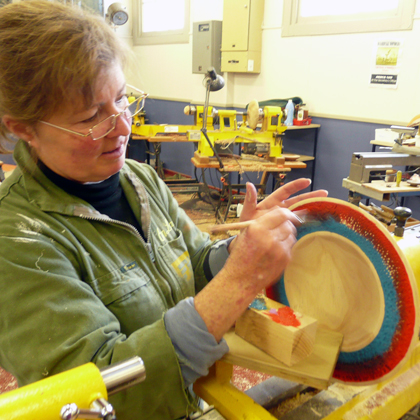

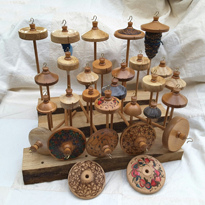
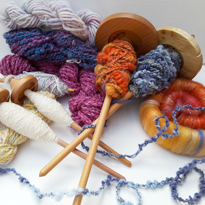
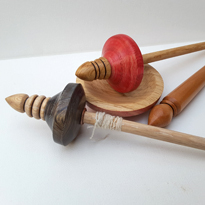
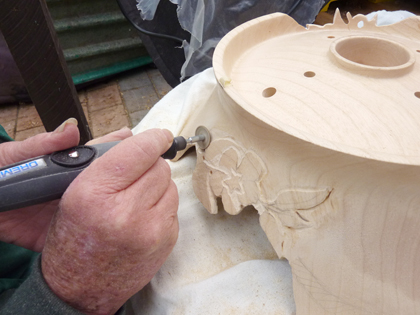

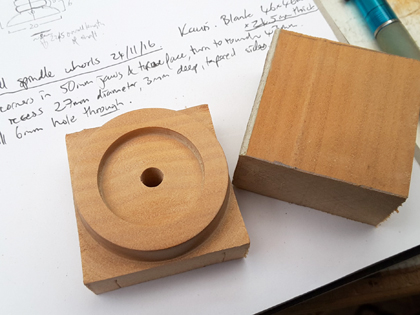

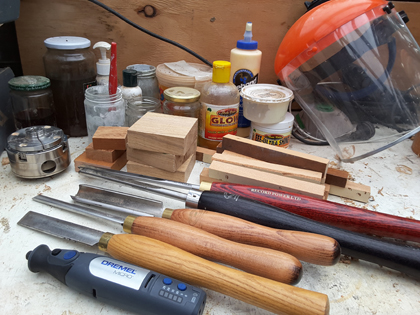
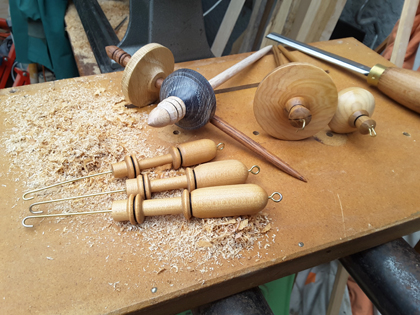
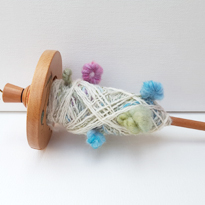
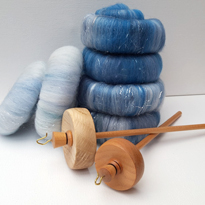
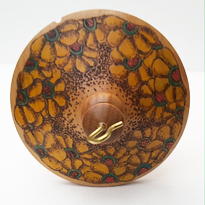
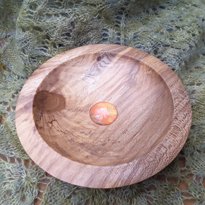
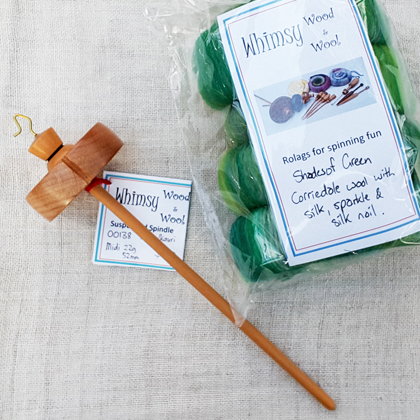
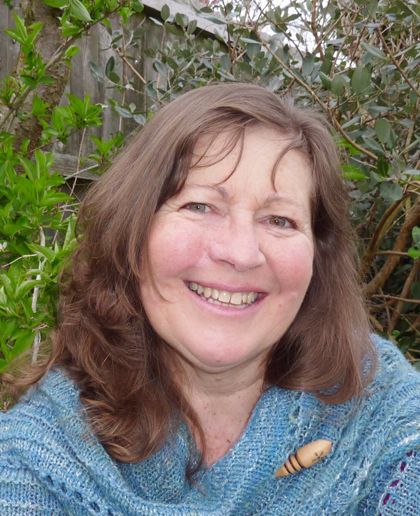





I just love these! I love anything to do with fibre, and it looks so gorgeous beside the natural turned wood. I have tried making my own drop spindles out of jar lids and old chopsticks, but would just love to win one of these!
I would love to try spinning my own wool with a Tedge tool, they look so well made with love. My current yarn projects (and there are plenty!) ate latch hooking, punch needle, weaving and pom pom making.
Beautiful and functional! That’s is what appeals.
I love to knit and crochet, and now making soap for a change.
Have spun in the past and would love to try using the spindle 🙂
Oh wow these are amazing! I love that Tedge uses natural products, I have a very similar philosophy when it comes to my fibre work. The detail in her products are amazing! I’ve just started spinning my own yarn to use for my knitting and crochet products and I’m so addicted!
OMGoodness Tedge is amazing! I love how concisely and confidently she communicates about her creative process, business, and ethos. I struggle with that a lot myself, and she does it brilliantly. Her work is so beautiful!
I LOVE that Tedge tries to only use natural products. I know from experience that it can mean tough, and sometimes pricey, decisions. I learnt how to knit and crochet last year and feel like I’m learning something new every time I pick up my needles and hook!
I love that Tedge shared her creative process with us, and the shawl pins are lovely. My favourite thing to crochet is shawls, and I’m a new spinner and knitter. Just when I think I’ve got the right technique in my spinning something happens to make it go thick/thin/break
What I like about Tedge’s products is she makes and uses tools so she understands form and function. My favourite yarn craft is knitting and right now I am obsessed with shawls
Oh how lovely! I started reading this article hoping for a wooden yarn bowl, and am delighted to see them on Tedge’s to do list.
I love to knit and crochet, mainly small projects like hats, scarves, mittens, cloths and doilies. Theres enough yarn here to insulate my house, but i still find colours and textures irresistible,